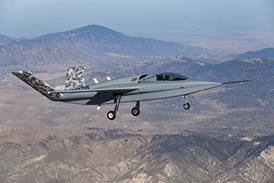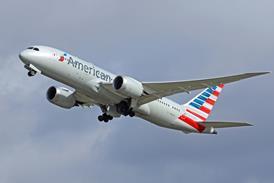After RVSM, terrain awareness systems and Mode S, general aviation operators now face new navigation requirements. But the benefits may outweigh the costs
As Eurocontrol and the US Federal Aviation Administration continue to implement required navigation performance (RNP) standards for airspace users, airlines and general-aviation operators in Europe and the USA could see increased opportunities to fly more direct routes, execute more efficient approaches and departures, and reduce transit times, fuel consumption and flight delays.
The European air traffic control agency began to implement RNP in 1998, initially on an R-NAV (area navigation) basis. In North America, the FAA is in the first stages of a three-phase RNP plan that could include most US airspace by 2020, according to its Roadmap for Performance-Based Navigation issued in 2003.
Coming after the wholesale introduction of reduced vertical separation minima (RVSM), and mandates to install terrain awareness warning systems in the USA and Mode S datalinks in Europe, operators are wary that RNP compliance will entail yet more expensive avionics upgrades. But the benefits could outweigh their concerns.
RNP is concerned with lateral separation and the capability of aircraft flying under instrument flight rules to remain within a specified margin of a given track line, between origin and destination and during approach and departures. For example, under RNP-10 – currently mandated for aircraft flying transpacific routes – aircraft must maintain a 50nm (93km) lateral separation, but are allowed a ±10nm deviation from their assigned track. That deviation margin must be maintained for at least 95% of the time the aircraft is within RNP-10 airspace. This year, Eurocontrol will establish precision area navigation (P-RNAV) standards that will require RNP-1 capability (cross-rack accuracy of ±1nm) in terminal areas.
RNP is less dependent on specific ground-based navigation aids, and more upon the demonstrated capability of the onboard sensors to keep the aircraft in compliance with the separation minima for en route airspace or the terminal area. Because of the demanding nature of RNP, the capability of avionics to meet the required performance standards will be a significant issue for many operators.
More hardware
"As you go from one level of RNP to another, it may require additional hardware and software to be added," says Chuck McLeran, president of AMI Jet Charter of San Francisco. "For aircraft already modified for some level of RNP compliance, my guess is that they won't require a great deal of additional modification." When AMI began to fly within RNP-10 airspace over the north and central Pacific about five years ago, it was "surprised at how well" the business jet manufacturers had prepared their aircraft for RNP.
"The first aircraft that we flew through RNP-10 Pacific airspace was a Bombardier Challenger 604 we had on our certificate," he says. "We found that Bombardier had already published a supplemental flight manual for that aircraft, which showed it was already RNP-10 capable."
Mark Grunewald, Gulfstream's national sales manager – avionics, says that, in most instances, customers will have to obtain a revised flight manual supplement and/or software upgrades for RNP andP-RNAV levels of certification. "Operators of aircraft not equipped with flight management systems [FMS], or not capable of RNP or P-RNAV certification levels, will face significant hardware costs in order to meet minimum RNP and P-RNAV requirements," he says. "Right now, there is a lot of RNP certification activity in progress."
Grunewald says that P-RNAV is already addressed in the current flight manual supplement for the Gulfstream IV and V. "It provides the local [FAA] flight standards district offices specific aircraft compliance data to meet TGL-10 [Eurocontrol's guidelines for P-RNAV compliance]. This is required to obtain a letter of authorisation from the FAA, needed to operate within ICAO major and non-major terminal airspace." P-RNAV compliance programmes for the Gulfstream G100 and G200, Challenger 601-3A and -3R, Dassault Falcon 900 and Raytheon Hawker 800 will be available late in the second quarter of this year, he says.
Multi-sensor approach
Chris Nehls, Honeywell Commercial Electronic Systems' senior marketing manager, says the avionics manufacturer is taking "a multi-sensor approach" to specific aircraft RNP compliance requirements. This usually involves making modifications to the aircraft's FMS, and its DME and VOR navigation receivers. The aircraft's GPS receiver is also enhanced to work with any of four satellite-navigation augmentation systems, including the space-based wide area augmentation system (WAAS), ground-based local area augmentation system (LAAS), onboard integrated global-positioning/inertial-navigation system, and the GPS regional augmentation system (GRAS), which, like LAAS, is ground-based. "How you achieve RNP compliance, based on the airspace requirements that you have is a function of the systems installed on your aircraft and how those systems are integrated to give you the [required] performance level," Nehls says.
David Wu, director of flightdeck systems marketing, business and regional aircraft for Rockwell Collins, says that for an aircraft to be RNP-capable its FMS has to constantly monitor the integrity of input from the onboard GPS and ground-based navaids. "The standards needed to do this will be an evolving development, and will be based on market demand," he says.
"RNP upgrades will involve some combination of hardware and software changes, and ultimately will depend on the age of the aircraft," Wu says. "And the decision to make the upgrades will also depend upon where and when RNP procedures will be implemented, and how that relates to where the operators fly."
Although the FAA has yet to set any national RNP standards, it has approved what are known as private RNP procedures within the USA. Private RNP procedures, as the term implies, are developed by individual carriers for their exclusive use at specific airports.
Alaska Airlines is currently the sole carrier with exclusive RNP approval for approach, arrival and departure procedures in the USA. Starting in 1996 at Juneau, Alaska, the airline has received FAA approval for a total of 15 approaches, and 15 departures, under RNP-0.3 procedures developed in-house, but with input from Boeing and the FAA. Most are in Alaska at Cordova, Ketchikan, Kodiak, Petersburg, Sitka, and Rangel; with two in California at San Francisco and Palm Springs. Sarah Dalton, the Seattle-based airline's director, airspace and technology, says Alaska is designing RNP procedures for Portland International in Oregon, and Reagan National in Washington DC, with FAA approvals expected this year.
"From the standpoint of safety of flight, RNP provides a stable, vertical path for approaches," Dalton says. "In Alaska there are several airports with non-precision approaches that have no vertical guidance. RNP eliminated a very time-consuming step-down process in favour of a constant descent angle. We have also been able to reduce the ceiling and forward visibility for operation at those airports."
Extensive upgrade
Dalton says approval for these procedures required an extensive avionics upgrade for the carrier's fleet of 40 Boeing 737-400s. "That involved adding redundancies to the essential navigation systems, specifically the FMS, GPS and IRS [inertial reference system]," she says. "We also installed new displays that enhanced the pilots' situational awareness. The upgrade also included enhanced ground proximity warning systems. There were also unique RNP procedures, for which the pilots had to be trained."
Dalton stresses that RNP is about more than just equipment. It also involves an elaborate navigation data cross-checking process. "As a pioneer in developing the criteria for RNP procedure design, we realised that when you are flying RNP, you must rely heavily on the accuracy of the navigation database," she says. "That meant developing procedures to verify its integrity with every [vendor-supplied] update to the database, which generally occurs every 28 days." The updates normally involve the way in which waypoints are quoted. "Every piece of data in the updates must be compared with the information in the previous version. If anything has changed, we research it in order to determine what impact, if any, it will have on the operations," she says.
Unlike its 737-400s, the carrier's Next Generation 737 fleet, consisting of-700s, -800s and -900s, came off the assembly line RNP-capable. However, David Jones, Boeing's RNP programme manager, commercial aviation/flight services, says that while all new-production Boeing aircraft are similarly equipped, customers must still select from the available software options needed for their specific operations. But for operators of older Boeing equipment, Jones says, essential RNP-related hardware would include an advanced FMS incorporating a radius to fix (RF) feature that maintains ground-tracking capability to a much greater extent than older models.
Also required would be dual GPS, with multi-mode receivers combining GPS and ILS capabilities. "The dual-GPS multimode receivers built today have future upgrade capability for LAAS/GLS [global landing system] landing capability," Jones says. "In fact, one customer is taking delivery within the next few months of a Next Generation 737 which has a LAAS/GLS-capable system already on board and certified."
Business jet manufacturer Cessna has made all of its current production aircraft RNP-5 compliant. But Cessna is moving toward more stringent RNP-1 capabilities, says Marcelo Casenove, the Wichita-based manufacturer's supervisor, Citation customer service, avionics and operational services. This is being done using a Honeywell Primus 1000 avionics package coupled with a Universal UNS-1Esp or UNS-1L FMS. The Primus 1000/UNS package is scheduled for certification by year-end on the current production Citation Bravo, Encore and XLS models. "This is the most popular and straightforward combination, and we expect that certification will be relatively simple," he says.
Casenove says certification is also expected by year-end for RNP-1 on the Citation X, which will use Honeywell Primus 2000 avionics and FMS; and the Citation Sovereign, which is equipped with Honeywell Primus Epic avionics and flight management systems. By the second quarter of next year, Cessna l expects to gain RNP-1 certification for its entry-level CJ1, CJ2 and CJ3 using a combination of Rockwell Collins avionics and various Universal FMSs or the Garmin 530 navigation management system.
"We expect that once certification is completed, demand will come from buyers of new aircraft, as well as from those already in the field. Many of these aircraft are equipped with non-RNP systems, and will need to be retrofitted to operate in certain regions," says Casenove. "RNP-1 retrofits will be mainly driven by compliance with P-RNAV, which is now required in certain European areas of high-density traffic and limited air traffic management."
Bill Stone, avionics product manager for Garmin International in Olathe, Kansas agrees. "RNP is now more of a factor in Europe because it satisfies the EuropeanB-RNAV [Basic RNAV] and P-RNAV requirements, but it only makes sense to do this in the USA. As new technology comes out, it can fall into RNP operations," he says.
Garmin's major aviation GPS product, the GNS 430/530, is compliant with European B-RNAV and P-RNAV, as well as with RNP-10 for the Pacific. Stone believes that, should the USA go to RNP, it will further drive the market for modern technology retrofits.
Sensor-independent
"RNP will give operators the ability to use the air traffic control system on a sensor-independent basis," he says. "This means that the selection of the equipment to meet RNP standards is up to the operator – as long as it has been validated to provide a specific degree of accuracy and integrity. The concern is not with the core technology, but rather the ability of whatever technology you have on the aircraft to accurately calculate its position. As technology moves along, you test it and validate it to show that it can be folded into the RNP [operational] environment."
Kevin King, a product specialist with Meggitt/S-TEC of Mineral Wells, Texas, says the GPS Steering (GPSS) system introduced in the late 1990s by S-TEC (acquired by Meggitt in 2000), is a potentially valuable RNP tool because it ensures the aircraft will stay within the RNP limitations, provided that the autopilot's navigator is properly programmed. "Because the autopilot uses the roll steering data supplied by the GPS, the aircraft will fly exactly what the GPS tells it to, based on whatever course heading the pilot has set up within the GPS," he says. "As a totally automated system, it prevents any overshooting or deviation from the waypoints, and makes the transition from one waypoint to the other as smooth as possible."
RNP holds potential promise for more efficient operations for both the air carrier and general aviation communities. Fortunately, a growing number of new production aircraft are being built with RNP capability and, for older aircraft, the avionics manufacturers appear to be ready with upgrade systems at a time when RNP is still in its comparatively early stages in Europe, and still mostly in the planning stages in North America.
PAUL SEIDENMAN/SAN FRANCISCO
Source: Flight International























